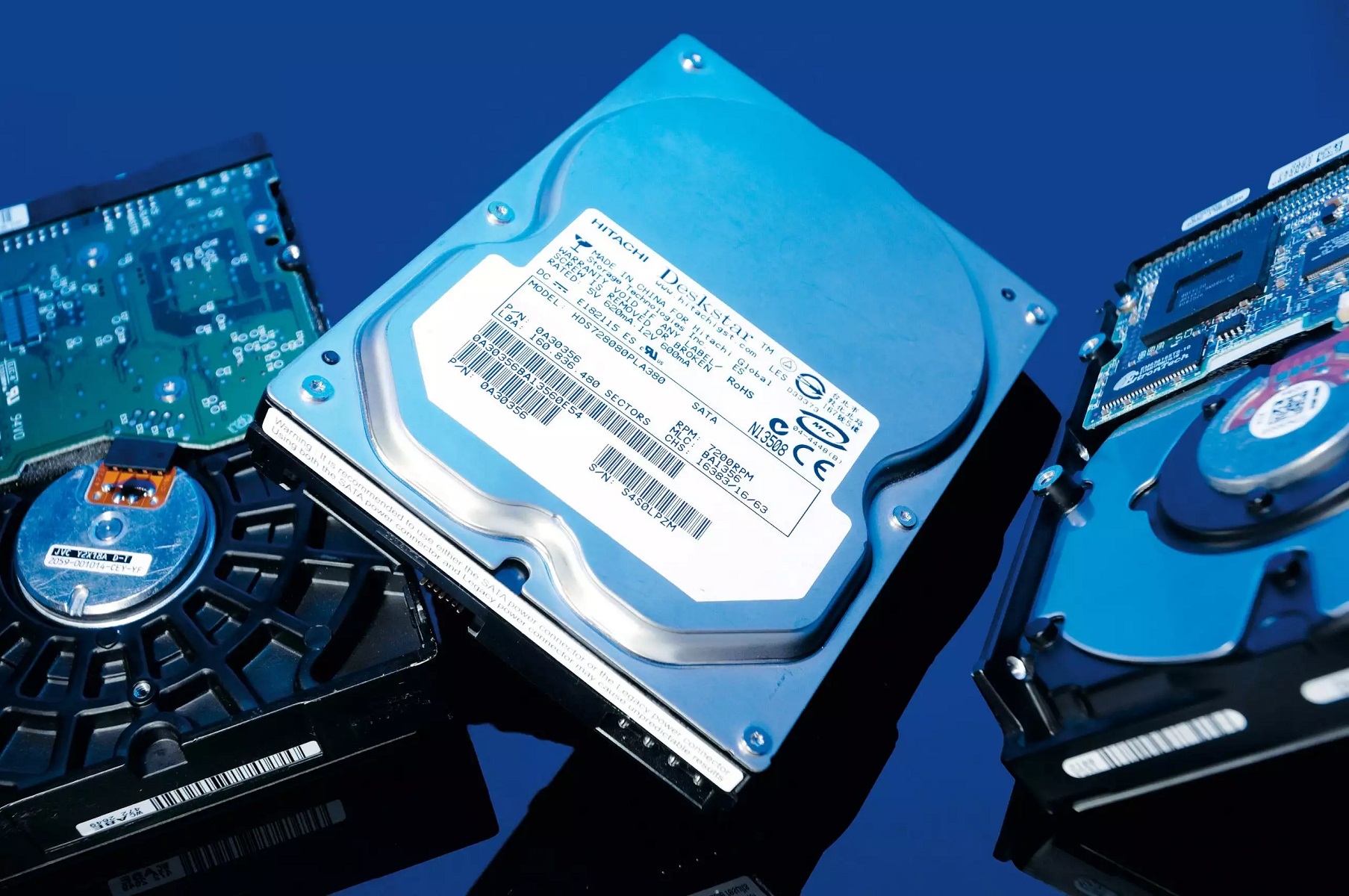

Articles
What Is Storage In Computer
Modified: January 6, 2024
Learn what data storage is and how it works in computers. Discover different types of storage devices and their importance in managing and accessing data.
(Many of the links in this article redirect to a specific reviewed product. Your purchase of these products through affiliate links helps to generate commission for Storables.com, at no extra cost. Learn more)
Introduction
In the world of computers, storage plays a crucial role in storing and organizing data. Whether it’s a personal computer or a massive data center, without proper storage, information would be lost or inaccessible. Computer storage refers to the ability of a computer system to retain and retrieve data. It encompasses both hardware and software components that work together to store and manage information.
The concept of computer storage can be traced back to the early days of computing when punch cards and magnetic tapes were used to store data. Over the years, storage technology has evolved exponentially, providing faster, more reliable, and higher-capacity storage solutions.
Understanding the basics of computer storage is essential for anyone using a computer or working in the field of information technology. This article will explore the different types of computer storage, their characteristics, and their significance in modern computing.
Key Takeaways:
- Understanding the basics of computer storage, including primary and secondary storage, flash storage, magnetic storage, and optical storage, is crucial for efficient data management and accessibility in the digital age.
- Keeping abreast of future trends in computer storage, such as advancements in SSD technology, cloud and hybrid storage solutions, and quantum storage, will enable individuals and organizations to leverage evolving storage technologies for enhanced performance and security.
Read more: What Is A CAD Computer
Basics of computer storage
Computer storage can be thought of as a digital warehouse where data is stored and retrieved by the computer system. It allows users to save files, install software, and store various types of digital content such as documents, images, videos, and more.
The fundamental unit of computer storage is the binary digit, or bit, which represents the smallest unit of data. A bit can have two possible values, 0 or 1, and it forms the building blocks of all digital data. A group of eight bits is known as a byte, which is commonly used to measure storage capacity.
Computer storage can be broadly classified into two categories: primary storage and secondary storage. Primary storage, also known as main memory or RAM (Random Access Memory), is the temporary storage area that holds data and instructions actively being used by the computer’s processor. It is volatile, meaning that its contents are lost when the computer is powered off or restarted. Primary storage provides fast access to data, allowing the computer to perform tasks efficiently.
On the other hand, secondary storage refers to non-volatile storage that retains data even when the computer is turned off. It is used for long-term storage of data and is typically larger in capacity compared to primary storage. Secondary storage devices include hard disk drives (HDDs), solid-state drives (SSDs), flash drives, optical discs, and magnetic tapes.
Primary and secondary storage work together to ensure smooth functioning of a computer system. When you open a file or launch a program, the necessary data is loaded from the secondary storage into the primary storage. The processor then accesses and manipulates the data as needed, and any changes are ultimately saved back to the secondary storage.
Next, let’s delve into the different types of computer storage in more detail.
Types of computer storage
Computer storage comes in various forms, each with its own set of characteristics and advantages. Here, we’ll explore some of the most common types of computer storage:
Primary storage
As mentioned earlier, primary storage is the immediate storage area accessed by the computer’s processor. The two main types of primary storage are:
- Random Access Memory (RAM): RAM is volatile memory that stores data and instructions currently being used by the computer. It provides fast access to information, allowing the processor to quickly retrieve and manipulate data. RAM is essential for multitasking and running applications.
- Cache Memory: Cache memory is a smaller, faster, and more expensive type of primary storage. It serves as a temporary buffer between the CPU and the main memory, storing frequently used data for quick retrieval. Cache memory helps improve the overall performance of the computer system.
Secondary storage
Secondary storage refers to non-volatile storage that retains data even when the power is turned off. Some common types of secondary storage include:
- Hard Disk Drives (HDDs): HDDs are the most widely used form of secondary storage. They consist of spinning disks, called platters, coated with a magnetic material. Data is stored magnetically on these platters, and the read/write heads access the data rapidly. HDDs offer large storage capacities and are commonly used in desktop and laptop computers.
- Solid-State Drives (SSDs): SSDs are a newer form of secondary storage that use flash memory technology. Unlike HDDs, SSDs have no moving parts, resulting in faster access times, lower power consumption, and increased durability. SSDs are commonly found in laptops, ultrabooks, and high-performance desktops.
- Flash Storage: Flash storage includes USB flash drives, memory cards, and solid-state drives. It uses a type of non-volatile memory called flash memory to store data. Flash storage offers portability, high durability, and fast access times, making it popular for storing and transferring data in various devices.
- Optical Storage: Optical storage uses optical discs, such as CDs, DVDs, and Blu-ray discs, to store and retrieve data. Data is written onto the disc’s reflective surface using a laser beam. Optical storage is widely used for distributing software, movies, music, and archival purposes.
- Magnetic Tapes: Magnetic tapes are sequential storage devices used for high-capacity data backup and archival purposes. They consist of a long plastic tape coated with a magnetic material. Magnetic tapes offer cost-effective storage for large volumes of data.
Each type of storage has its advantages and is suitable for different applications. The choice of storage depends on factors like speed, capacity, portability, cost, and data reliability.
In the next sections, we’ll explore primary storage, secondary storage, and their respective subtypes in more detail.
Read more: What Is A Computer Adapter
Primary storage
Primary storage, also known as main memory or RAM (Random Access Memory), is a crucial component of a computer system. It serves as the immediate storage area that holds data and instructions actively being used by the computer’s processor. Primary storage provides fast access to data, allowing the computer to perform tasks efficiently.
There are two main types of primary storage:
- Random Access Memory (RAM): RAM is a type of volatile memory that stores data and instructions currently being used by the computer. It is considered the temporary workspace of the computer. Any information stored in RAM is lost when the computer is powered off or restarted. RAM is crucial for multitasking and running applications smoothly. A larger RAM capacity enables the computer to handle more programs simultaneously without slowdowns.
- Cache Memory: Cache memory is a smaller, faster, and more expensive type of primary storage. It is built directly into the CPU or placed nearby for speedy access. Cache memory functions as a temporary buffer between the CPU and the main memory (RAM). It stores frequently used instructions and data to provide faster access and reduce the latency associated with retrieving data from the main memory. The cache memory is organized into multiple levels, such as L1, L2, and L3 cache, with L1 cache being the closest and fastest to the CPU.
RAM is crucial for a computer’s performance. When you open an application or launch a program, the necessary data and instructions are loaded from the secondary storage into the RAM. Once in RAM, the processor can quickly access and manipulate the data. The larger the RAM capacity, the more data can be stored, reducing the need to constantly access the slower secondary storage.
Cache memory, on the other hand, is designed to provide extremely fast access to frequently used data. It helps bridge the speed gap between the CPU and RAM. When the CPU needs certain instructions or data, it first checks the cache memory. If the required information is present in the cache, known as a cache hit, it can be retrieved almost instantly. If the information is not found in the cache, known as a cache miss, it needs to be fetched from the main memory, resulting in a slight delay.
Together, RAM and cache memory significantly impact a computer’s performance. They enable quick access to data, allowing the CPU to process instructions efficiently. The amount of primary storage a computer has directly affects its multitasking capabilities and overall responsiveness.
In the next section, we will explore secondary storage, which provides long-term storage for data even when the computer is turned off.
Secondary storage
Secondary storage, also known as external storage or auxiliary storage, refers to non-volatile storage that retains data even when the power is turned off. Unlike primary storage, which provides temporary storage for actively used data, secondary storage is used for long-term storage of data and files.
There are several types of secondary storage devices commonly used in computer systems:
- Hard Disk Drives (HDDs): HDDs are the most widely used form of secondary storage. They consist of spinning disks, called platters, which are coated with a magnetic material. Data is stored magnetically on these platters, and the read/write heads access the data rapidly. HDDs offer large storage capacities and are commonly used in desktop and laptop computers. They provide a good balance between cost, capacity, and performance.
- Solid-State Drives (SSDs): SSDs are a newer form of secondary storage that utilize flash memory technology. Unlike HDDs, SSDs have no moving parts. Instead, they store data using microchips, making them faster, more reliable, and less susceptible to physical damage. SSDs offer faster data access times, reduced power consumption, and increased durability. They are commonly found in laptops, ultrabooks, and high-performance desktops. While SSDs tend to have smaller storage capacities compared to HDDs, their speed and performance benefits are highly desirable.
- Flash Storage: Flash storage encompasses devices like USB flash drives, memory cards, and solid-state drives (SSDs). It uses a type of non-volatile memory called flash memory, which retains data even when the power is turned off. Flash storage devices are popular for their portability, small form factor, and ability to transfer data quickly. They are commonly used for storing and transferring files, especially in devices like cameras, smartphones, and tablets.
- Optical Storage: Optical storage refers to the use of optical discs, such as CDs, DVDs, and Blu-ray discs, as a storage medium. Data is written onto the disc’s reflective surface using a laser beam. Optical discs provide a convenient and affordable means of distributing software, movies, music, and archival purposes. While optical storage has been largely eclipsed by digital downloads and streaming, it remains relevant for specific applications that require physical media.
- Magnetic Tapes: Magnetic tape storage involves the use of magnetic tapes, wound onto reels or cartridges, for long-term data backup and archival purposes. It is a sequential storage medium, meaning that data is accessed sequentially rather than randomly. Magnetic tapes offer immense storage capacities, cost-effectiveness, and durability. They are commonly used in enterprise-level data centers and organizations that require high-capacity backups or archival storage.
Each type of secondary storage has its own advantages and is suitable for different applications. Factors such as speed, storage capacity, portability, cost, and data reliability should be considered when selecting the appropriate storage solution.
In the next sections, we will delve deeper into the characteristics and applications of each type of secondary storage.
Flash storage
Flash storage is a type of non-volatile memory that is widely used for storing and transferring digital data. It offers high-speed access, portability, and durability, making it an essential storage solution in a variety of devices. Flash storage can be found in devices such as USB flash drives, memory cards, and solid-state drives (SSDs).
The key technology behind flash storage is flash memory, a type of solid-state storage that retains data even when the power is turned off. Flash memory is composed of cells that store data using electric charges. It is organized into blocks, each consisting of multiple pages. Each page can store a certain amount of data, typically 4KB or 8KB.
Flash storage has several advantages over traditional magnetic storage options, such as hard disk drives (HDDs). Here are some key benefits of flash storage:
- Fast Access and Transfer Speeds: Flash storage offers much faster access and transfer speeds compared to HDDs. It has no moving parts, which eliminates the time required for mechanical read/write operations. This results in quicker data access, shorter boot times, and faster file transfers.
- Reliability and Durability: Flash storage is highly durable because it has no mechanical components that can wear out over time. It is resistant to shocks, vibrations, and extreme temperatures, making it suitable for use in rugged environments.
- Compact Form Factor: Flash storage devices are compact and lightweight, making them highly portable. USB flash drives and memory cards can easily fit in pockets or wallets, allowing users to carry their data with them wherever they go.
- Efficient Power Consumption: Flash storage consumes less power compared to traditional storage devices. This is beneficial for laptops, smartphones, and other battery-powered devices, as it helps extend battery life.
- Greater Data Security: Flash storage provides enhanced data security. It is more resistant to data corruption and is less susceptible to magnetic fields, which can cause data loss on traditional magnetic storage devices.
Solid-state drives (SSDs) are a popular implementation of flash storage in computers. SSDs offer faster boot times, faster application launches, and faster file access compared to HDDs. They have become increasingly popular due to their improved performance, reliability, and decreasing costs.
In addition, USB flash drives and memory cards are widely used as portable storage solutions. They allow users to store and transport files between different devices easily. USB flash drives can be plugged into USB ports on computers, laptops, or even certain mobile devices, providing instant access to stored data.
Flash storage has revolutionized the way we store and access data. As technology continues to advance, we can expect further improvements in terms of capacity, speed, and affordability.
In the next sections, we will explore other types of computer storage, including magnetic storage and optical storage.
Magnetic storage
Magnetic storage is a traditional method of storing and retrieving data using magnetized materials. It has been widely used for decades and is still prevalent in various forms of computer storage. Magnetic storage devices store information by manipulating magnetic fields on a medium, typically a disk or tape.
One of the most common examples of magnetic storage is the hard disk drive (HDD). Hard disk drives consist of one or more rigid disks, known as platters, coated with a magnetic material. Data is stored as magnetic patterns on the platters’ surfaces, and read/write heads, positioned above the platters, magnetically read and write data. Hard disk drives offer high storage capacity, fast access times, and affordable pricing.
While hard disk drives are the primary form of magnetic storage, there are other types of magnetic storage devices as well:
- Magnetic Tapes: Magnetic tapes were once the dominant form of computer storage, primarily used for backups and archival purposes. They consist of a long plastic tape coated with a magnetic material. Historically, magnetic tapes have offered high capacity and cost-effectiveness for storing large amounts of data sequentially, although they have largely been replaced by other storage technologies in day-to-day computer usage.
- Floppy Disks: Floppy disks were widely used in the early days of personal computers. They were small, portable, and came in different sizes, with the most common being 3.5-inch and 5.25-inch floppy disks. Floppy disks offered a modest storage capacity and were used for storing and transferring small amounts of data.
- Magnetic Strip Cards: Magnetic strip cards, such as credit cards or identification cards, utilize magnetic storage to store information. A magnetic stripe on the back of the card contains data that can be read by card readers or machines. This data can include account information, personal identification, and more.
Magnetic storage devices have played a vital role in computer systems for many years. They provided reliable storage solutions with high capacities and reasonable cost per gigabyte. However, with advancements in technology, other storage technologies such as solid-state drives (SSDs) and flash storage have gained popularity due to their faster access times, lower power consumption, and increased durability.
Despite the rise of newer storage technologies, magnetic storage still has its place in various applications, particularly in large-scale data centers and enterprise-level systems where cost-effectiveness and high-capacity storage are essential.
In the next section, we will explore another form of computer storage—optical storage—which uses laser technology to read and write data.
Read more: What Is A Printer In Computer
Optical storage
Optical storage is a type of computer storage that uses laser technology to read and write data on optical disks. Optical storage devices, such as CDs, DVDs, and Blu-ray discs, rely on the ability to create and read microscopic pits on the surface of these discs.
Here are the main types of optical storage commonly used:
- Compact Disc (CD): CDs were one of the first widely adopted optical storage formats. They have a storage capacity of up to 700MB and are commonly used for storing audio, software, and multimedia files. CDs are read-only (CD-ROM), write-once (CD-R), or rewritable (CD-RW) formats.
- Digital Versatile Disc (DVD): DVDs have a higher storage capacity than CDs, ranging from 4.7GB for single-layer DVDs to 8.5GB for dual-layer DVDs. DVDs are commonly used for movies, software distribution, and large data backups. Similar to CDs, DVDs can be read-only (DVD-ROM), write-once (DVD-R), or rewritable (DVD-RW or DVD+RW) formats.
- Blu-ray Disc (BD): Blu-ray discs offer the highest storage capacity among optical storage media, ranging from 25GB for single-layer discs to 50GB for dual-layer discs. Blu-ray discs are used for storing high-definition video content, large data backups, and high-capacity software installations.
The reading and writing of optical discs are accomplished using laser technology. A laser beam is focused on the surface of the disc, and the reflection or absorption of the laser light by the microscopic pits determines whether that area represents a binary 0 or 1. This information is then translated into digital data that can be understood by the computer.
Optical storage offers several advantages:
- Portability: Optical discs are lightweight and easy to transport, making them a convenient option for sharing files and distributing software.
- Longevity: Optical discs are quite durable and can typically withstand scratches, dirt, and general wear and tear, allowing for long-term storage and archiving of data.
- Compatibility: Optical discs are designed to be compatible with a wide range of devices, including CD/DVD/Blu-ray drives in computers, home theater systems, gaming consoles, and standalone disc players.
- Data Integrity: Once data is written to an optical disc, it is generally not susceptible to corruption or alteration. This makes optical storage suitable for long-term archival purposes.
Despite its advantages, optical storage has become less prominent in recent years due to the rise of other storage technologies, such as solid-state drives (SSDs) and cloud storage. These alternatives offer higher capacities, faster access times, and greater convenience. However, optical storage still finds its applications in scenarios where physical media distribution, data archiving, or content delivery are necessary.
In the next section, we will explore solid-state drives (SSDs), which have become increasingly popular due to their superior performance and reliability.
Solid-state drives
Solid-state drives (SSDs) are a type of computer storage that have gained significant popularity in recent years. Unlike traditional hard disk drives (HDDs) that rely on spinning disks and moving read/write heads, SSDs use flash memory technology to store and retrieve data. This results in several advantages over HDDs, making SSDs a preferred choice for many users.
Here are the key characteristics and benefits of solid-state drives:
- Faster Performance: SSDs offer significantly faster data access and transfer speeds compared to HDDs. Access times for reading and writing data are much shorter, resulting in faster boot times, quicker application launches, and overall smoother system performance.
- No Moving Parts: Unlike HDDs, which contain spinning disks and moving read/write heads, SSDs have no mechanical components. This absence of moving parts makes SSDs more resistant to physical shock and reduces the risk of mechanical failure.
- Reliability: SSDs have a lower failure rate compared to HDDs. Since there are no moving parts that can wear out over time, SSDs are generally more reliable in terms of data loss and hardware failure.
- Energy Efficiency: SSDs consume less power than HDDs, resulting in reduced power consumption and longer battery life in laptops and other portable devices. This makes SSDs more energy-efficient and contributes to a greener computing environment.
- No Noise: The absence of moving parts in SSDs eliminates the noise generated by spinning disks and read/write operations, resulting in a quieter computing experience.
- Compact Form Factor: SSDs are available in various form factors, including standard 2.5-inch drives and smaller M.2 drives. This compact size allows for easy installation in laptops, ultrabooks, and other slim devices.
SSDs utilize flash memory technology, which is a type of non-volatile memory that retains data even when the power is turned off. Flash memory is composed of cells that can store multiple bits of data. These cells are organized into pages, and pages are further grouped into blocks.
When data is written to an SSD, it is stored in specific cells within the flash memory. To improve performance and prolong the lifespan of the drive, SSDs employ wear-leveling algorithms, which distribute data evenly across the available cells. This ensures that each cell is used evenly over time, preventing premature wear and extending the life of the drive.
Due to their superiority in performance, durability, and efficiency, SSDs have become the preferred choice for both personal computers and enterprise-level systems. They are widely used in laptops, desktops, servers, and high-performance computing applications.
It’s worth noting that SSDs generally have a higher cost per gigabyte compared to HDDs. However, as SSD technology continues to evolve and manufacturing costs decrease, they are becoming more affordable and accessible to consumers.
In the next section, we will discuss the importance of storage capacity and how it affects your computer’s storage capabilities.
Storage in a computer refers to the physical devices used to store data, such as hard drives and solid-state drives. It is essential for saving files and running programs. Understanding the different types of storage options can help you make informed decisions when upgrading or purchasing a computer.
Storage capacity
Storage capacity refers to the amount of data that a storage device can hold. It is one of the crucial factors to consider when choosing a storage solution for your computer, as it determines how much data you can store and access.
Both primary and secondary storage devices have different storage capacities, and it’s important to understand the capabilities of each type:
- Primary Storage: Primary storage devices, such as RAM and cache memory, have relatively smaller storage capacities compared to secondary storage. RAM capacity directly affects a computer’s ability to multitask and handle multiple programs simultaneously. A larger RAM capacity allows for better performance and smoother multitasking, but it does not serve as long-term storage since its contents are lost when the computer is powered off.
- Secondary Storage: Secondary storage devices offer larger storage capacities and serve as long-term storage for your data. Hard disk drives (HDDs), solid-state drives (SSDs), flash drives, and optical discs come in a range of storage capacities, varying from gigabytes (GB) to terabytes (TB) and even petabytes (PB) in data centers. The choice of secondary storage capacity depends on your storage requirements, such as the amount of data you need to store, whether you are storing personal files or running a business, and the scalability you desire.
The storage capacity you need will depend on your specific requirements and budget. Consider the following factors when determining the appropriate storage capacity:
- Usage: Determine how you plan to use the storage. If you are a casual user who needs to store personal documents, photos, and videos, a storage capacity of a few hundred gigabytes may suffice. However, if you are a professional dealing with large multimedia files, complex software, or running a server, you may require several terabytes of storage space.
- Growth: Consider your future storage needs. If you anticipate your data requirements to expand over time, it’s wise to opt for a higher storage capacity to accommodate future growth. This prevents the need for frequent upgrades or the hassle of having to transfer data to larger storage devices later on.
- Backup and Redundancy: It’s essential to allocate enough storage capacity for proper data backup and redundancy. Backing up important files ensures that you have a secondary copy in case of data loss or system failure. Redundancy helps protect against data loss by having multiple copies of your data stored in different locations or on different storage devices.
- Cost: Storage capacity often comes at a cost. Larger storage capacities, especially in high-performance storage solutions like SSDs, can be more expensive. It’s important to find a balance between your storage needs and your budget.
As technology advances, storage capacities continue to increase, while the cost per gigabyte decreases over time. This allows for more affordable and higher-capacity storage options for consumers and businesses alike. Keep in mind that different storage technologies have different cost structures, with SSDs generally offering higher capacities at a higher cost compared to HDDs.
Understanding your storage capacity needs and considering the factors mentioned above will help you choose the appropriate storage solution that meets your requirements now and in the future.
In the next section, we will discuss file systems, which are vital for organizing and managing data on storage devices.
File systems
File systems play a crucial role in organizing and managing data on storage devices. They provide a structure and a set of rules for how data is stored, accessed, and managed within a storage device, such as a hard disk drive (HDD) or solid-state drive (SSD).
Here are some key points about file systems:
- Definition: A file system is a method of organizing and structuring data on a storage device to facilitate efficient storage, retrieval, and management of files and directories.
- Hierarchical Structure: File systems typically employ a hierarchical structure, consisting of directories (also known as folders) and files. Directories can contain both files and subdirectories, allowing for a hierarchical organization of data.
- Metadata: File systems store metadata, which includes information about files and directories, such as file names, file sizes, creation dates, access permissions, and file attributes. This metadata is used by the operating system to manage and locate files.
- File Naming Conventions: File systems impose rules for naming files, including restrictions on characters, maximum length, and case sensitivity. These naming conventions ensure compatibility and consistency across different operating systems and applications.
- Access Control: File systems provide access control mechanisms to define and enforce permissions for accessing and modifying files and directories. Permissions can be set for individual users or groups, allowing for secure data management.
- File System Types: There are various file system types used in different operating systems. Some common file system types include FAT (File Allocation Table), NTFS (New Technology File System), HFS+ (Hierarchical File System Plus), ext4 (Fourth Extended File System), and APFS (Apple File System).
- Compatibility: File system compatibility is an important consideration when transferring data between different devices or operating systems. File systems can be compatible or incompatible with certain operating systems, which may affect the ability to access and manipulate data.
- Formatting: Formatting a storage device involves initializing it with a specific file system. The formatting process prepares the device to store and manage data using the chosen file system. It erases any existing data and structures the drive to be compatible with the selected file system.
The choice of file system depends on the operating system and the intended use of the storage device. Different file systems have different performance characteristics, features, and limitations. For example, some file systems are optimized for compatibility across multiple platforms, while others prioritize advanced features like journaling for data integrity or large file support.
Additionally, file systems may have limitations in terms of maximum file size, maximum number of files in a directory, or overall storage capacity of the device. It’s important to consider these factors when selecting a file system and formatting a storage device.
File systems are an integral part of data management and play a crucial role in the organization and accessibility of files and directories on storage devices. Understanding file systems and their features is essential for effective data management and ensuring compatibility across different systems and devices.
In the next section, we will explore storage management techniques to optimize the utilization of storage resources and improve efficiency.
Read more: What Is The Most Common Type Of Storage Device For Transferring Files From One Computer To Another
Storage management
Storage management refers to the processes and techniques involved in effectively utilizing and managing storage resources within a computer system. It involves organizing, optimizing, and maintaining storage devices to ensure efficient and reliable data storage and retrieval.
Here are some key aspects of storage management:
- Capacity Planning: Capacity planning involves estimating and forecasting storage needs based on current and future data requirements. This helps in determining the appropriate amount of storage capacity needed to accommodate data growth and avoid potential storage shortages.
- Allocation and Provisioning: Storage allocation involves assigning storage resources to users, applications, or specific data sets based on their requirements. Provisioning refers to the process of making the allocated storage resources available to the intended users or applications.
- Data Tiering: Data tiering is the practice of categorizing data based on its value or access frequency and storing it on different tiers of storage devices accordingly. Frequently accessed or critical data may be placed on high-performance storage, such as solid-state drives (SSDs), while less frequently accessed or less critical data may be stored on lower-performance but more cost-effective storage.
- Backup and Recovery: Storage management includes implementing backup and recovery strategies to protect data from loss or corruption. Regularly backing up important data and having an effective recovery plan in place ensures that data can be restored in the event of hardware failure, human error, or other disasters.
- Data Deduplication and Compression: Data deduplication and compression techniques reduce storage consumption by identifying and eliminating duplicate or redundant data and compressing data to occupy less space. These techniques optimize storage utilization and can result in significant storage savings.
- Data Archiving and Retention: Data archiving involves moving infrequently accessed data from primary storage to long-term archival storage. Archiving helps free up valuable space on primary storage and ensures that data is retained securely and in compliance with legal and regulatory requirements.
- Monitoring and Performance Tuning: Storage management involves monitoring storage systems to detect and resolve performance issues. This includes monitoring storage utilization, throughput, latency, and other performance metrics. Performance tuning techniques may be applied to optimize storage performance and ensure efficient data access.
Implementing effective storage management practices helps ensure optimal utilization of storage resources, improves data accessibility and reliability, and reduces costs. By effectively managing storage, organizations can enhance overall system performance, streamline data management processes, and improve data protection and recovery procedures.
Automated storage management tools and software solutions are available to simplify storage management tasks and provide centralized control and monitoring of storage resources. These tools offer features such as storage provisioning, capacity optimization, data protection, and performance monitoring, making storage management more efficient and effective.
With the exponential growth of data in today’s digital age, storage management plays a critical role in maintaining a well-organized and efficient storage infrastructure. It ensures that data is accessible, protected, and optimized for performance, enabling businesses and individuals to leverage their storage resources effectively.
In the next section, we will explore data retrieval and access methods, which are essential for retrieving stored data from storage devices.
Data retrieval and access
Data retrieval and access are fundamental processes that allow users to retrieve and interact with stored data on their computer systems. Whether it’s accessing files, running applications, or retrieving specific information, efficient data retrieval and access methods are essential for utilizing stored data effectively.
Here are some key points about data retrieval and access:
- File System Navigation: File systems provide a hierarchical structure that allows users to navigate through directories and access specific files. Users can browse through the directory structure to locate the desired file or use search functionalities to find files based on specific parameters like file name or file type.
- File Metadata: File systems store metadata associated with each file, such as file name, size, creation date, and permissions. This metadata is used by the operating system to manage and locate files. Users can utilize file metadata to filter and sort files and access the desired information quickly.
- File Opening and Execution: When a user opens a file or launches an application, the operating system locates the file on the storage device and loads it into the primary storage (RAM) for execution. Once in the RAM, the data and instructions are accessible to the processor, allowing the application to run and the user to interact with the data.
- Data Retrieval Methods: Data can be retrieved from storage devices through various methods, depending on the storage technology being used. For sequential access storage devices, such as magnetic tapes, data is accessed sequentially from start to end. In contrast, random access storage devices, like hard disk drives (HDDs) and solid-state drives (SSDs), allow for direct and quick retrieval of data from any location on the storage medium.
- Remote Data Access: With the advent of cloud computing and network-connected storage devices, remote data access has become increasingly popular. Users can access their data remotely over the internet using various protocols and remote access methods, allowing them to retrieve and interact with their data from different locations and devices.
- Data Security and Permissions: Data retrieval and access are subject to security measures and permissions set by the file system. These measures ensure that users can only access data that they are authorized to access and protect sensitive information from unauthorized access.
- Backup and Restoration: In the event of data loss or system failure, data retrieval from backups is crucial. Regular backups allow users to restore their data to a previous state, minimizing data loss and downtime. Backup and restoration processes should be well-defined and regularly tested to ensure data can be retrieved effectively when needed.
The speed and efficiency of data retrieval and access depend on various factors, including the storage device’s technology, data location on the device, and the performance of the storage interface (e.g., SATA, NVMe). Factors such as storage capacity, I/O operations per second (IOPS), and latency also influence data retrieval times.
Advancements in storage technology, such as solid-state drives with their faster access times and improved performance, have significantly enhanced data retrieval and access speeds. Additionally, cloud storage services have provided convenient and seamless access to data from anywhere in the world, further expanding possibilities for data retrieval and collaboration.
Efficient data retrieval and access methods are vital for productivity, ensuring that users can retrieve the information they need quickly and interact with their data efficiently. It’s important to optimize storage systems, streamline file management processes, and leverage technologies that enable fast, secure, and reliable data retrieval and access.
In the next section, we will explore future trends and advancements in computer storage that shape the landscape of data storage and access.
Future trends in computer storage
The field of computer storage is continually evolving, driven by the demands of increasing data volumes, the need for faster access times, and advances in technology. Several future trends are shaping the landscape of computer storage, offering exciting possibilities for data storage and access:
- Solid-State Drives (SSDs) and Flash Storage: SSDs and flash storage technology will continue to advance, with increasing storage capacities and decreasing costs. As the demand for faster and more reliable storage solutions grows, SSDs will become the mainstream choice, eventually replacing traditional hard disk drives (HDDs) in most computing devices.
- Non-Volatile Memory Express (NVMe): NVMe is an interface protocol designed specifically for SSDs, enabling faster data transfer rates and lower latency compared to traditional storage interfaces. NVMe SSDs are becoming more prevalent, offering significant performance gains over previous storage interfaces, and they are expected to become the standard for high-performance storage solutions.
- Cloud Storage and Hybrid Storage: The adoption of cloud storage services will continue to rise, offering scalable and flexible storage solutions. Hybrid storage architectures, combining on-premises storage with cloud storage, will become more common, allowing organizations to leverage the benefits of both local and cloud-based storage for cost-effectiveness, data redundancy, and accessibility.
- Object Storage: Object storage is a data storage architecture that organizes data as discrete objects rather than traditional hierarchical file systems. This approach allows for massive scalability, better metadata management, and improved data durability. Object storage is gaining popularity for cloud storage, big data analytics, and archival use cases.
- Quantum Storage: Quantum storage, based on the principles of quantum mechanics, holds the potential for storing vast amounts of data in extremely small spaces. Quantum storage research aims to develop technologies that can store and access data at the atomic or subatomic level, enabling unprecedented data densities and energy-efficient storage architectures.
- Software-Defined Storage (SDS): SDS decouples storage hardware from the software that manages it, allowing for greater flexibility, scalability, and cost efficiency. SDS abstracts storage resources and allows them to be managed and allocated as needed, simplifying storage management and enabling organizations to optimize their storage infrastructure.
- Data Protection and Security: With increased data breaches and privacy concerns, there will be a greater focus on data protection and security in storage systems. Advances in encryption technologies, data deduplication, and data integrity verification will play a significant role in ensuring the confidentiality and integrity of stored data.
These future trends promise to revolutionize data storage and access, providing more efficient, scalable, and secure storage solutions. As technology continues to evolve, we can expect even greater storage capacities, faster transfer speeds, and more innovative storage architectures.
Emerging technologies, such as holographic storage, DNA-based storage, and advanced machine learning algorithms for storage management, also hold promise for the future of data storage.
It’s important to stay informed about these trends and advancements to adapt storage strategies and leverage the evolving storage technologies to meet the growing demands of data storage and access in the digital age.
To conclude, the future of computer storage brings exciting possibilities for enhanced performance, increased capacities, improved security, and innovative storage architectures that will reshape the way we store and access data.
Conclusion
In the world of computer storage, advancements in technology and evolving trends are continuously shaping the way we store, access, and manage data. From the basics of computer storage to the future of storage technology, it’s clear that storage plays a critical role in our digital lives.
We explored various types of computer storage, including primary storage, secondary storage, flash storage, magnetic storage, and optical storage. Each type has its unique characteristics, benefits, and applications. Primary storage, consisting of RAM and cache memory, provides fast access to data actively used by the computer’s processor. Secondary storage, including HDDs, SSDs, and optical discs, offers larger storage capacities for long-term data storage and retrieval.
We also discussed the importance of storage capacity and the role it plays in determining how much data we can store and manage. Proper storage management techniques, such as capacity planning, allocation, and backup strategies, are essential for efficiently utilizing storage resources and ensuring data accessibility and security.
Data retrieval and access methods are crucial for effectively interacting with stored data. Understanding file systems, utilizing metadata, and employing efficient data retrieval techniques enable easy navigation, retrieval, and execution of files and applications. Remote data access, backup and restoration processes, and security measures ensure data availability, integrity, and protection.
We explored future trends in computer storage, including advancements in SSD and flash storage technology, the rise of cloud and hybrid storage solutions, developments in object storage, quantum storage, and software-defined storage (SDS). These trends indicate an exciting future with increased storage performance, scalability, and security.
In conclusion, computer storage is a vital component of our digital world. As technology continues to evolve, storage capacity, efficiency, and accessibility will continue to improve. It is crucial to stay informed about the latest trends and advancements in storage technology to leverage the full potential of data storage and provide efficient data management and accessibility.
Whether it’s for personal use or enterprise-level storage systems, understanding the fundamentals of computer storage and embracing future trends will enable us to make informed decisions and harness the power of data in our modern digital age.
Frequently Asked Questions about What Is Storage In Computer
Was this page helpful?
At Storables.com, we guarantee accurate and reliable information. Our content, validated by Expert Board Contributors, is crafted following stringent Editorial Policies. We're committed to providing you with well-researched, expert-backed insights for all your informational needs.













0 thoughts on “What Is Storage In Computer”